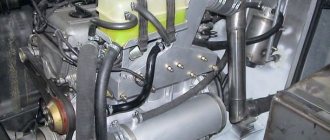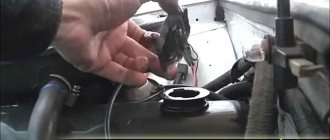How much oil is in the VAZ 2109 engine
Maintaining a normal oil level in the engine of your VAZ 2109 is the key to the good functioning of the “heart” of your car. According to the operating instructions, the amount of oil in the engine of this model is indicated at 3.5 liters, however, in practice, 3 liters are usually filled.
To carry out the procedure for replacing the oil filter and oil in the engine of your VAZ 2109, you need to use a special key. However, if it is missing, you can pierce the filter housing with a regular screwdriver, and then remove the filter using the screwdriver as a lever.
It is best to change the oil in a VAZ 2109 engine on a warm engine. In a cold engine, the oil becomes viscous and may not drain completely. In this case, it is necessary to warm up the engine to an operating temperature of approximately 80 degrees.
Technology for changing the oil in the VAZ 2109 engine
Place your car on a flat, horizontal area. It is advisable to place the car above the inspection pit or on a special overpass.
When changing the oil, it is recommended to intermediately flush the engine with a special flushing oil liquid or oil of the brand that you plan to fill in your engine. To carry out flushing, after draining the used oil, use a funnel to fill in fresh oil so that its level reaches the bottom line on the dipstick. Let the engine run without load for about ten minutes, then proceed to add fresh oil.
To comply with environmental regulations, do not allow used oil to come into contact with the soil.
Place a wide-mouth container under the crankcase of your engine, disconnect the drain plug and drain the used oil, then close the drain hole.
Remove the old oil filter using a special wrench. Lubricate the seal ring with the same engine oil.
Using a funnel, pour new oil into the engine. Check its level using the oil dipstick.
Remove the oil dipstick, clean it of any oil and place it back in the inspection hole. Pull out the dipstick. The normal oil level mark should be between the maximum and minimum marks.
After this, start your engine again and drive it for several minutes without load at idle speed. After turning off the engine, check the oil level again using the dipstick and add it if necessary.
Source
Oil change tips
It is better to change the VAZ 2109 engine oil in an inspection pit or overpass. Otherwise, to unscrew the drain plug you will need to crawl under the car by lifting the front of the car.
The oil should only be changed when the engine is hot. To drain it completely, you must wait at least 10-15 minutes after unscrewing the drain plug.
To easily remove the oil filter, it is better to use a special puller. But when installing a new filter, it must be tightened exclusively by hand.
If you decide to change the oil in a VAZ 2109 with an engine flush, then washing oils (VNIINP-FD, MSP-1, MPT-2M) will help you with this.
The tools you will need to change the oil are: 17" and 24" wrenches; balloon; oil filter remover; containers for used oil; gloves; jack; bedding on the ground; rags; new filter; new oil.
How much oil is in the VAZ-2109 engine (injection and carburetor)
Changing the engine oil of a VAZ-2109 car is a simple task that does not require professional skills. Even an inexperienced motorist can handle this. And at first glance it may seem that in practice everything is as simple as in theory. And even experienced owners may have questions, given the fact that the VAZ-2109 is an unpredictable car that requires regular maintenance. In this article we will look at which oil is best to choose for the VAZ-2109, when to change it and how much to fill.
Oil change interval
The AvtoVAZ company has established an oil change schedule for the VAZ-2109. It is about 10 thousand kilometers, but may vary depending on climatic and road conditions. The worse the conditions, the shorter the fluid change interval. The fact is that under the influence of negative factors, oil quickly loses its beneficial properties. As a result, the fluid becomes unusable, and with it the engine components. It is possible that an untimely oil change will lead to a major overhaul of the engine, and in the worst case, you will have to buy a new power unit assembly. Therefore, it is advisable to replace it according to the regulations, or even better, look at the condition of the oil. After all, if the fluid has darkened and smells burnt, then replacement may be required much earlier - for example, after 5 thousand kilometers.
Oil change procedure step by step
1. Put the car on a jack and remove the front right wheel, but you don’t have to do this if there is an inspection hole.
2. Find the drain plug and prepare a canister for used oil, substitute the canister and unscrew the plug.
3. Oil flowed into the canister.
4. Unscrew the oil filler plug.
5. We wait until all the waste has flowed out and screw the plug back in.
7. Unscrew the old filter, it is also located at the bottom of the engine.
8. Pour a little oil into the new filter and lubricate the rubber band with it, install the filter in its place.
9. Fill in the oil according to the instructions, three liters, and put back the oil filler plug.
10. Start the engine and look at the indicator in the form of an oil can; the light should go out.
11. That’s it, the lamp has gone out, which means everything is in order in the system, there is oil. Let the engine run for another five minutes.
12. To make sure that everything is in order, we look into the filler hole; oil should splash. That's it, the process is complete.
Which oil to choose
There are three types of oil, let's look at them in more detail.
- Synthetic is the most modern oil today. In general, this lubricant is recommended for foreign cars, but it is also quite suitable for the VAZ-2109. This is the most fluid and liquid oil, resistant to low temperatures and freezing. It is important to take into account the fact that such a liquid costs a little more than other oils.
- Mineral is the cheapest product recommended for high mileage. Since the VAZ-2109 is a relatively outdated car, such oil will be sufficient for it. But on the other hand, mineral liquid is extremely susceptible to low temperatures and can quickly freeze. As a result, startup problems may occur. Based on this, we can conclude that it is better to fill in mineral oil with high mileage, and only in warm and not too cold weather.
- Semi-synthetic oil - represents seven synthetic and mineral oils. This product can be considered the best option for the VAZ-2109. It is definitely better than mineral water, but at the same time much worse than pure synthetics. Semi-synthetics will also not be the best option at low temperatures. And yet, given the lack of money for normal oil, VAZ-2109 owners will have enough of this oil.
All-season is the name given to any of the above oils. This liquid has average viscosity values. All-season oil can be used in moderately low temperatures as well as in hot weather. For the VAZ-2109, all-season oil with SAE parameters 5W-40, or 10W-40 or 15W-40 is suitable.
The manufacturer prohibits mixing oil of different types and with different parameters. It is necessary to fill in the oil that was originally filled.
Oil selection table by season (winter, summer)
Oil for VAZ 2109 1987-2006.
| Year | Viscosity SAE all season from +25 to -25 °C | winter from -35 to 0 °C | summer from 0 to +35 °C |
| 5W-20 5W-30 10W-30 | 20W-30 20W-20 25W-30 |
| 5W-20 5W-30 10W-30 | 20W-30 20W-20 25W-30 |
| 5W-20 5W-30 10W-30 | 20W-30 20W-20 25W-20 25W-30 |
| 5W-20 5W-30 10W-30 | 20W-30 25W-20 25W-30 |
| 5W-30 10W-40 10W-30 | 20W-30 25W-20 25W-30 |
| 5W-30 10W-40 10W-30 | 20W-30 25W-20 25W-30 |
| 5W-30 5W-40 10W-40 | 20W-30 20W-40 25W-20 25W-30 |
| 5W-30 5W-40 10W-40 | 20W-30 20W-40 25W-30 |
| 5W-30 10W-30 | 20W-30 25W-30 |
| 5W-30 10W-30 | 20W-30 25W-30 25W-20 |
| 5W-20 5W-30 10W-30 10W-40 | 20W-30 25W-30 |
| 5W-30 | 20W-30 25W-30 |
| 5W-30 5W-40 | 20W-40 20W-30 25W-30 |
| 5W-30 5W-40 | 20W-40 20W-30 25W-30 |
| 5W-20 5W-30 5W-40 | 20W-40 20W-30 25W-30 25W-40 |
| 5W-20 5W-30 5W-40 | 20W-40 20W-30 25W-30 25W-40 |
| 5W-20 5W-30 5W-40 | 20W-40 20W-30 25W-30 25W-40 |
| 5W-30 5W-40 0W-30 | 20W-40 20W-30 25W-30 25W-40 |
| 5W-40 | 20W-40 25W-30 25W-40 |
| 0W-30 5W-40 5W-30 | 20W-30 20W-40 25W-30 |
+25 to -25 °Cwinter
-35 to 0 °Csummer
from 0 to +35 °CGasoline APIDiesel APITypeRecommended Manufacturers200710W-40 5W-40
| 0W-30 5W-40 | 20W-40 25W-30 25W-40 |
| 0W-30 0W-40 | 20W-40 25W-40 |
| 0W-40 5W-40 | 20W-40 25W-40 25W-40 |
| 0W-40 5W-40 | 20W-40 25W-40 |
| 0W-30 0W-40 5W-40 | 20W-40 25W-40 |
VAZ 2109 oil change, tolerances and volume
In order for the engine to operate reliably, efficiently and for a long time, it is extremely important to monitor the quality and quantity of oil in it.
For the VAZ 2109, the recommended engine oil change interval is 10 thousand kilometers. But you need to focus on your specific situation. Practice shows that replacement is sometimes carried out much more often.
What affects the replacement frequency
Each car manufacturer provides detailed information in the car manual about when to change the engine oil. However, the fact is that this information is not always correct. As a rule, the documentation contains a value of 10...15 thousand kilometers (in each individual case the number may differ). But in reality, several factors influence the mileage between replacements.
10 indicators that affect the timing of engine oil changes
- Type of fuel (gas, gasoline, diesel) and its quality
- Engine capacity
- Brand of previously filled oil (synthetic, Semy-Synt, mineral oil)
- Classification and type of oils used (API and longlife system)
- Engine oil condition
- Replacement method
- Total engine mileage
- Technical condition of the car
- Operating conditions and modes
- Quality of consumables
The manufacturer's instructions are not included in this list, since for him the service interval is a marketing concept.
Operating modes
First of all, the timing of engine oil changes is affected by the operation of the vehicle. Without delving into the essence of the various transient processes, it is worth mentioning two main modes - on the highway and in the city. The fact is that when a car drives along the highway, firstly, the mileage accumulates much faster, and secondly, normal cooling of the engine occurs. Accordingly, the load on the engine and the oil used in it is not so high. On the contrary, if the car is used in the city, then its mileage will be significantly lower, and the load on the engine will be higher due to the fact that it often stops at traffic lights and traffic jams with the engine running. The cooling will be insufficient.
In this regard, it would be more intelligent to calculate how long it takes to change the engine oil, based on engine hours , as is done in truck, agricultural and water equipment. Let's give an example. The car will travel 10 thousand kilometers in urban conditions (at an average speed of 20...25 km/h) in 400...500 hours. And the same 10 thousand on the highway at a speed of 100 km/h - in only 100 engine hours. Moreover, the operating conditions of the engine and oil on the highway are much milder.
Driving in a metropolitan area is rightly equated to driving on rough off-road conditions in terms of how it destroys oil. This is especially true when its level in the crankcase is below average, and even worse when it is less than the minimum level. Also remember that in hot summer weather the oil is subject to a much greater load due to high temperatures, including from the hot surface of roads in big cities.
Engine size and type
What affects the frequency of oil changes
The more powerful the engine, the easier it is for it to survive load changes, as well as difficult operating conditions. Accordingly, the oil will not have such a strong impact. For a powerful engine, driving along the highway at a speed of 100...130 km/h does not exert a significant load; it will be below average. As the speed increases, the load on the engine, and therefore on the oil, will change smoothly.
Small cars are another matter. As a rule, they are equipped with a “short” transmission, that is, the gears are designed for a small speed range and operating speed range. Accordingly, small engines experience greater loads in critical conditions than powerful ones. When the load on the engine increases, the temperature of its pistons also increases, and the amount of crankcase gases also increases. This leads to a general increase in temperature, including oil temperature.
It’s especially hard for small-displacement forced engines (for example, 1.2 TSI and others). In this case, the load is also supplemented by a turbine.
Additional factors
This includes high temperature control (operating temperature), poor ventilation of the engine crankcase (especially when driving in urban conditions), the use of low-quality or unsuitable oil for a given engine, the presence of dirt in the oil channels, a clogged oil filter, and the operating temperature range of the oil.
It is believed that the optimal engine oil change interval is from 200 to 400 operating hours under various operating conditions, with the exception of maximum load, including driving at maximum speed and maximum rpm.
The type of oil used is also of great importance - mineral, semi-synthetic or fully synthetic. You can read about each of the mentioned types separately using the links provided.
Why change the oil
There are conditions that must be adhered to so that the lubricant present in the engine system fulfills its protective functions and does not become the cause of failure of the power unit.
There are several main points, you need to change the oil.
| Cause | Explanation |
| Recommended mileage exceeded | Each part has its own service life, during which the spare part uses up its existing resource. There is no point in continuing to use oil that should have been drained long ago. Otherwise, it may cause serious problems with the engine. |
| Change of seasons | For winter and summer, it is recommended to fill in the appropriate type of lubricant. This is due to the degree of viscosity, outside temperature, characteristics of the intensity and cooling of the engine in winter and summer. |
| Changing the oil brand | If you want to switch to a new brand of oil, the old one must be completely removed from the system. Under no circumstances should you mix different oils, even by brand. |
| Difficult conditions | If the car is regularly operated under high load conditions, oil changes are carried out more often than recommended intervals. |
This is what old oil looks like
Often in the summer they like to fill in more viscous oil than for the winter. During prolonged operation in the engine, it loses its properties, additives, and chips from the engine's rubbing parts begin to adversely affect its condition. Over time, if the oil is not changed, this may lead to the need for major engine repairs.
When to change
According to the instructions for “eight” and “nine” cars, the oil should be changed at least every 10,000 km. However, there are a number of nuances when the mileage for replacement is reduced or the oil needs to be changed:
- When buying a car second-hand, you need to change the oil. As a rule, the previous owner of the car, trying to “save money,” does not resort to changing the oil. Therefore, changing the oil on a newly purchased car will protect your engine from unpleasant surprises.
- After the car has been idle for a long time. For example, after winter storage, it is better to change the lubricant to a new one, since when the engine is idle for a long time, condensation accumulates in it. Mixed with engine oil, this suspension will negatively affect engine parts, causing their premature wear.
- The operating conditions of the vehicle should also be taken into account. An aggressive driving style, as well as driving in urban conditions, contributes to intensive wear of internal parts. As a result, particles of metal shavings get into the engine lubricant, thereby worsening the lubricating properties of the oil.
A little about oil
Before you begin the replacement procedure, you need to find out what and in what quantity should be filled.
In VAZ 2109 cars (1.5L engines) usually fill from 3 to 3.5 liters of oil. At the same time, we recommend buying a standard 4 liter canister so that you have something to add during operation.
Check the oil level periodically with a dipstick. It is optimal for a trace of oil to remain on the dipstick between the maximum and minimum marks. Golden mean. It’s not worth filling above the maximum level, just like driving with a level below the minimum.
We have decided on the volume of oil. What exactly should it be?
The most important thing in disputes about motor oils: we will not name brands or viscosities. Let's just say that the oil must NOT be fake and comply with the car manufacturer's approval. For VAZ it is ACEA A3/B3 or A3/B4, or API SJ, SL, SM, SN. Please note that API certification is required only for the USA, but if it is assigned to the oil you have chosen, you can buy with confidence.
Experience shows that VAZ engines run on semi-synthetic for a long time. The initial requirements of the manufacturer are mineral water, because... The motor was developed a very long time ago. Semi-synthetic oils are very suitable, do not leak through oil seals and seals, and are not consumed.
In terms of viscosity, VAZ engines run great all year round on 5w40 oil. If you wish or need to start it in frosts below -35 degrees, you can fill it with 0w40, and in the summer, on the contrary, 10w40.
Replacement
Now let's get down to work. There is nothing complicated here, so even a beginner can cope with the task.
- Prepare a container in advance where you will drain the used motor oil from the engine. A regular 5 liter plastic bottle will do just fine. Plus, you'll need a funnel so you don't miss it and spill oil on the floor.
- Warm up the engine. When the engine is hot, the oil becomes less viscous, which allows it to flow out of the system more efficiently and quickly when drained.
- Place the car on a flat surface and turn on the handbrake.
- Drain the old oil. To do this, remove the engine protection, if any.
- Place a drain container under the crankcase pan and unscrew the drain plug with a 17 mm wrench.
- Don't forget, the oil is hot, so unscrew it carefully to avoid burns. Unscrew while pressing the cork to the pan so that at the last moment you can quickly remove your hand with the cork and not get burned.
- After removing the drain plug, wait about 10-15 minutes until all the oil is drained into the prepared container.
- In parallel with changing the engine oil, it is recommended to change the oil filter. This can be done while the grease is draining. The filter is unscrewed with a special key or screwdriver, breaking through the housing. A new oil purifier is installed in its place. Before installing a new filter, fill it with oil!
- When the oil has completely drained, return the plug to its place.
- Pour some oil into the new filter. This must be done in several approaches so that the element has time to absorb the substance. Filling to about half the filter level is enough.
- Be sure to oil the filter rubber seal and wipe the seat of the filter device dry with a dry rag. Place the filter in place and tighten it by hand.
- Next, you will need to either simply add fresh oil or flush the system. Nowadays you can find a variety of cleaning products in any auto parts store. Take one of them and follow the instructions. After completing the flushing, you can fill in new lubricant.
- To fill, open the lid on the motor and gradually begin pouring liquid through the funnel.
- Fill in about 3 liters and wait until the lubricant is distributed throughout the system.
- Gradually add another 500 milliliters of liquid. At the same time, monitor the amount of oil in the crankcase using a dipstick. If you have not flushed the system, you will probably have to fill in a little less than 3.5 liters. This is due to the imperfection of the drainage system.
- Make sure that the dipstick shows the mark between the maximum and minimum lubrication levels.
- Screw on the cap, start the engine and let it idle for a while. This will allow the liquid to fill the filter and channels.
- When you start the engine, the red oil pressure indicator light will come on. After a few seconds it will go out. If the lamp does not go out, most likely you have not screwed the filter on properly. Check it out.
- Stop the engine, take the dipstick again and check the actual oil level. If required, add a little to the optimum level.
- When completing work, be sure to check the system for signs of oil leaks. If the protection has been removed, return it to its place.
Such simple and consistent steps will help you change the engine oil yourself without unnecessary hassle. You already know how much to fill and what rules to follow.
Source
Features of replacing engine oil on VAZ 2108, 2109, 21099
Using the example of the 21083 carburetor engine of VAZ 21083, 21093, 21099 cars, we will consider some features of changing engine oil.
To complete the work, you will need an inspection hole, four liters of engine oil (see “Selection of engine oil for engines of VAZ 2108, 2109, 21099”), an engine oil filter puller (if desired, you can do without it), a container for collecting old oil (not less than 4 liters), a new oil filter (see “Selecting an oil filter for VAZ 2108, 2109, 21099 engines”).
Features of changing engine oil in the engine of VAZ 2108, 2109, 21099 cars
— The frequency of this procedure according to the technical regulations for engine 21083 is every 15,000 mileage. It is recommended to replace it before this period - 10,000 km, despite the fact that the service life of most modern motor oils is exactly 15,000.
— Change the oil on a warm engine.
Procedure for changing engine oil in a car engine
— We install the car on the inspection hole
The car should stand level, without rolls. Do not jack up or load any side. We put chocks under the wheels and raise the handbrake.
— Fill the new oil filter with fresh engine oil
It will be absorbed into its filter element and gradually settle while work is carried out. Periodically, before installing the filter on the engine, add oil to it and raise the level.
— Drain the old oil
Remove the cap from the oil filler neck in the engine valve cover. We place a container under the engine to collect old oil. Unscrew the drain plug in the engine crankcase. You will need a key to "17". Preferably a socket, cap or head. If there is engine protection without a slot for the plug, you will have to remove it too. We drain the old engine oil, being careful not to get caught in the stream and get burned. After draining the oil, it is recommended to wait 15-20 minutes until it drains completely.
Drain plug in a car engine sump
— Unscrew the engine oil filter
The easiest way to unscrew is with a puller. They come in different designs. In our example we use a three-jaw puller.
Removing the engine oil filter
If there is no puller, we pierce through the filter housing with a long screwdriver (closer to the end, so as not to damage the fitting on which it is screwed). Using a screwdriver as a lever, unscrew the filter. The direction of rotation is counterclockwise. After unscrewing and draining the oil from under the filter, wipe its seating surface on the cylinder block with a clean rag.
— We wrap the drain plug into the engine pan
Tighten it with a wrench until it stops.
— Install a new oil filter on the engine
Lubricate its O-ring with engine oil. Quickly put the filter on the fitting and screw it all the way (clockwise) by hand. We finally tighten it with both hands. The use of additional tightening devices is not recommended.
— Fill in fresh engine oil through the oil filler neck
It is most convenient to use a funnel. Fill in approximately three liters. Taking into account the old oil remaining in the channels of the engine lubrication system, it should be almost normal (3.5 liters). We wait approximately 5-10 minutes. Check the oil level on the dipstick. Must be between the MIN and MAX marks. Or a little higher. If there is not enough, add a little more again. We wait and check again.
Engine oil level on dipstick
Screw on the oil filler cap.
— Start the engine
After starting the engine, the emergency oil pressure indicator lamp in the instrument panel should go out and should no longer light up while the engine is idling.
After the engine warms up, we tighten the oil filter. With both hands we try to tighten it a little more (approximately 1/4).
Notes and additions
— Changing engine oil is similar for both carburetor and injection car engines.
— Very often, unscrewing the engine oil filter becomes a real problem, as it sticks to the seat on the cylinder block. There are several ways to unscrew it. Using a belt, a bicycle chain, a piece of sandpaper, etc. We looked at what we think are the most effective, allowing you to quickly and painlessly achieve results - either a puller or a screwdriver (cheap and cheerful).
Twokarburators VK - More information on the topic in our VKontakte group, on Facebook Twokarburators FS and on Odnoklassniki - Twokarburators OK
More articles on the engine of VAZ 2108, 2109, 21099 cars
— Why does engine oil leak under the engine valve cover?
— Increased engine oil consumption, reasons
— Blue smoke from the muffler, causes
— Decoking of engine piston rings
— Low engine oil pressure










